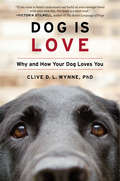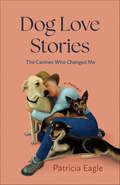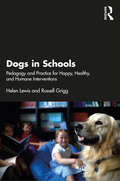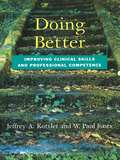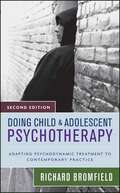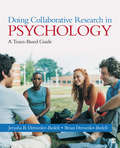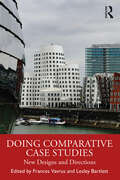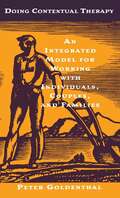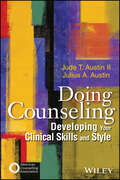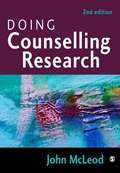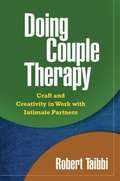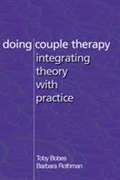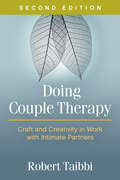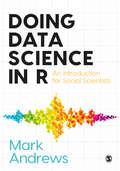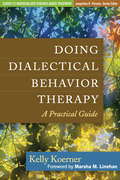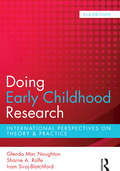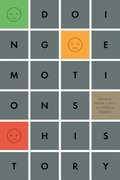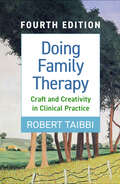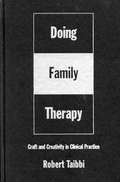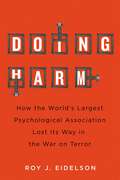- Table View
- List View
Dog Is Love: Why and How Your Dog Loves You
by Clive D.L. Wynne“Lively and fascinating... The reader comes away cheered, better informed, and with a new and deeper appreciation for our amazing canine companions and their enormous capacity for love.”—Cat Warren, New York Times best-selling author of What the Dog Knows Does your dog love you? Every dog lover knows the feeling. The nuzzle of a dog’s nose, the warmth of them lying at our feet, even their whining when they want to get up on the bed. It really seems like our dogs love us, too. But for years, scientists have resisted that conclusion, warning against anthropomorphizing our pets. Enter Clive Wynne, a pioneering canine behaviorist whose research is helping to usher in a new era: one in which love, not intelligence or submissiveness, is at the heart of the human-canine relationship. Drawing on cutting‑edge studies from his lab and others around the world, Wynne shows that affection is the very essence of dogs, from their faces and tails to their brains, hormones, even DNA. This scientific revolution is revealing more about dogs’ unique origins, behavior, needs, and hidden depths than we ever imagined possible. A humane, illuminating book, Dog Is Love is essential reading for anyone who has ever loved a dog—and experienced the wonder of being loved back.
Dog Love Stories: The Canines Who Changed Me
by Patricia EaglePerfect for dog lovers and fans of pet-centered memoirs like Julie Barton’s Dog Medicine, this heartfelt narrative captures the profound companionship humans share with dogs—and the ways these animals change lives. Patricia Eagle’s account of her lifetime of relationships with dogs reveals the clarity, strength, and wisdom she gained from them, even in the most challenging of situations. As Eagle chronicles the lives of her ten dogs over seven decades and the lessons she’s learned from them—including how to become a better dog owner and companion, and even a better human—her dogs come alive on the page, each with their own unique personality, from the feisty to the meek. If you are a dog person, if you are considering getting a dog yourself, or if you want to better understand someone who loves dogs—this book is for you. With the benefit of Eagle’s hard-earned wisdom, discover how dogs can change you and can help you learn to listen better, to trust and be trusted, to nurture with devotion, and to love with all your heart.
Dogs in Schools: Pedagogy and Practice for Happy, Healthy, and Humane Interventions
by Helen Lewis Russell GriggUsing a wealth of infographics and classroom examples, Dogs in Schools sets out the pedagogical principles that schools can employ to work with school dogs in a way that promotes the well-being of all participants and creates a safe environment for all. This is the first book to combine theory and research with the views of experienced teachers and professionals working around the world, from the United Kingdom to India, from Australia to mainland Europe. Their perspectives illustrate the wide-ranging interest in school dogs but also highlight common concerns. For policymakers, this is a book not to ignore because it shows how dogs have the potential to make a significant contribution to children's well-being at a time of growing concern in this area. Simultaneously, the authors endorse the views of contributors who call for the introduction of humane regulations and fulsome guidance so that school dogs are viewed as sentient companions and not relegated to the latest educational fad. This is a must-read book for all those who are serious about humane education and ensuring the well-being and happiness of both children and dogs.
Dogs in Schools: Pedagogy and Practice for Happy, Healthy, and Humane Interventions
by Helen Lewis Russell GriggUsing a wealth of infographics and classroom examples, Dogs in Schools sets out the pedagogical principles that schools can employ to work with school dogs in a way that promotes the well-being of all participants and creates a safe environment for all.This is the first book to combine theory and research with the views of experienced teachers and professionals working around the world, from the United Kingdom to India, from Australia to mainland Europe. Their perspectives illustrate the wide-ranging interest in school dogs but also highlight common concerns. For policymakers, this is a book not to ignore because it shows how dogs have the potential to make a significant contribution to children's well-being at a time of growing concern in this area. Simultaneously, the authors endorse the views of contributors who call for the introduction of humane regulations and fulsome guidance so that school dogs are viewed as sentient companions and not relegated to the latest educational fad.This is a must-read book for all those who are serious about humane education and ensuring the well-being and happiness of both children and dogs.
Doing Better: Improving Clinical Skills and Professional Competence
by W. Paul Jones Jeffrey KottlerDoing Better is intended to help therapists and counselors to explore more fully and systematically the processes of self-improvement in their work and lives.
Doing Child And Adolescent Psychotherapy: Adapting Psychodynamic Treatment To Contemporary Practice
by Richard BromfieldThis readable guide for therapists and therapists-in-training lays out the theoretical essence and practical essentials of doing child and adolescent psychotherapy from the referral call to the last goodbye.
Doing Collaborative Research in Psychology: A Team-Based Guide
by Jerusha B. Detweiler-bedell Dr Brian Detweiler-BedellDoing Collaborative Research in Psychology offers an engaging journey through the process of conducting research in psychology. Using an innovative team-based approach, this hands-on guide will assist undergraduates with their research—in their courses and in collaboration with faculty or graduate student mentors. The focus on this team-based approach reflects the collaborative nature of research methods and experimental psychology. Students learn how to work as a team, generate creative research ideas, design and pilot studies, recruit participants, collect and analyze data, write up results in APA style, and prepare and give formal research presentations. Students also learn practical ways in which they can promote their research skills as they apply to jobs or graduate school. A unique feature to this book is the ability to read chapters of the text either sequentially or separately, which allows the instructor or research mentor the flexibility to assign those chapters most relevant to the current state of the research project.
Doing Comparative Case Studies: New Designs and Directions
by Frances VavrusComparative Case Studies: New Designs and Directions extends the comparative case study methodology established by Bartlett and Vavrus and employed in many areas of social research, especially in education. This volume unites a diverse, international group of education scholars whose work exemplifies the affordances and constraints of the comparative case study (CCS) approach and offers new theoretical and empirical directions for researchers. In 11 engaging chapters, experts in comparative education, early childhood education, peace education, refugee education, special education, and teacher education discuss their use of the CCS approach to produce new ways of knowing and to address challenges of multi-scalar and multi-sited research. The first section, Conceptualizing Cases and Case Selection, emphasizes the importance of carefully selecting cases during different phases of research while continuously reflecting on how these choices influence the findings. The second section, Balancing Specificity and Generalizability, addresses the challenge of balancing the need for rich, deep data while including multiple sites. The third section, Enabling Processual Analysis across Sites and Scales, demonstrates the fit between the CCS approach and qualitative research that unfolds over time and space. Addressing the Transversal Axis, the fourth section, showcases research with a strong temporal dimension. The final section, New Directions, suggests inspiring and innovative methods. Offering rich methodological examples and provocative discussion questions, this volume will appeal to undergraduate and graduate students in education and research design courses, and to scholars and policymakers in diverse fields seeking to design studies of complex phenomena at different sites and scales.
Doing Contextual Therapy: An Integrated Model For Working With Individuals, Couples, And Families
by Peter GoldenthalThis book explains this deeply ethical approach of contextual therapy in practical terms and demonstrates its practice in extensive cases.
Doing Counseling: Developing Your Clinical Skills and Style
by Jude T. Austin II Julius A. AustinThis pragmatic book explains the “how” of integrating counselor training into practice by bridging the gap between educational knowledge, clinical skill, and counselor identity. Drs. Jude and Julius Austin combine their personal and professional experiences with contributions from other skilled clinicians to break down the counseling process and inspire counselor confidence in the ongoing quest to do counseling well. Following an introduction to basic counseling ethics and several types of sessions, each stage of counseling is explored, including presession preparation, meeting the client, building the therapeutic relationship, managing and trusting the process, developing a unique personal style, tracking therapeutic progress, ending therapy, and postsession tasks. The discussion then shifts to getting the most from supervision, competent multicultural/antiracist counseling, and the dos and don’ts of distance counseling. A sole case study is presented throughout the book to illustrate therapeutic techniques, and key takeaways are summarized in an epilogue. *Requests for digital versions from ACA can be found on www.wiley.com *To purchase print copies, please visit the ACA website here*Reproduction requests for material from books published by ACA should be directed to permissions@counseling.org
Doing Counselling Research
by John McleodWritten specifically for trainee and practising counsellors who intend to carry out research and for counsellors who want to use research findings in order to improve their practice, this book is the first practical, all-encompassing introduction to the strategies employed in counselling and psychotherapy research. Taking an interdisciplinary approach to counselling, the book guides the reader through the principles and the practice of undertaking a successful research project, describing how to locate, understand and critique relevant literature and how to gain access to useful research tools. John McLeod illustrates how to design and implement an effective study plan and gives a detailed account of the most useful research strategies, incorporating careful consideration of ethical issues at all stages of the research process. He goes on to discuss the dissemination of research findings and reporting of results. In addition, approaches to designing and carrying out research into the outcomes and processes of counselling are examined in detail. John McLeod stresses that research has a major role to play in developing services that are effective in helping clients. He places a special emphasis on qualitative and case-study approaches and encourages a critical appreciation of other methodological issues. Designed to make research more relevant and accessible, Doing Counselling Research will be an invaluable guide for all counselling and psychotherapy students and practitioners.
Doing Couple Therapy
by Robert Taibbi Richard SchwartzWise, compassionate, and highly practical, this engaging text covers the entire process of therapeutic work with couples, from opening sessions and assessment through skills building, core issues, and termination. Students and novice couple therapists learn effective strategies for intervening with couples of any age who are struggling with acute crises or longstanding conflicts and power struggles. Rich with sensitive, detailed case material, the book features numerous exercises that help readers identify and develop their own strengths as practitioners. Self-care strategies and tips for getting the most out of supervision are provided. Special topics include how to address couple issues with only one partner and couple therapy applications for chronic mental health problems.
Doing Couple Therapy Integrating Theory With Practice
by Toby Bobes Barbara RothmanHere, in one brief volume, are the answers to these questions and many others. Doing Couple Therapy will be a lifesaver for family therapy students and beginning therapists. In a straightforward manner, the authors sift through years of family therapy theory to draw out for readers a a treasury of ways to sort out the many factors, past and present, that crowd couples' relationships. These include family-of-origin issues, previous relationships, secrets, children, in-laws, unresolves lodes, job demands, financial worries--to name just a few. The authors' framework, built from the major influential theories of family and marital therapy, will enable therapists to work effectively and briefly, though not superficially, with couples. The book not only presents theory but also links theory with practice. An extraordinary contribution is the presentation of a typical case from beginning to end, through tender moments, rough spots, family-of-origin work, revelation of deeply held secrets, alcohol abuse, ultimatums, and finally, renewal of commitment to the relationship. This practical, real-life guide to couple therapy will give both students and seasoned therapists a new take on the demanding work of couple therapy.
Doing Couple Therapy, Second Edition: Craft and Creativity in Work with Intimate Partners
by Robert TaibbiNow thoroughly revised, this practical, user-friendly guide has helped thousands of novice couple therapists and students to navigate the challenges of clinical work with couples in conflict. Robert Taibbi presents effective strategies for rapidly identifying a couple's core issues and conducting each stage of therapy, from the first sessions to termination. Rich with sensitive case material, the book features end-of-chapter exercises that help readers identify and develop their own strengths as practitioners. Appendices include reproducible client handouts that can be downloaded and printed in a convenient 8 1/2" x 11" size. New to This Edition *Three chapters offering detailed treatment maps for common couple problems, with new case examples. *Chapter on the middle stages of treatment. *Increased attention to the all-important opening sessions. *Sharper focus on the three major obstacles to couple success: poor communication, emotional wounds, and differing visions. *Reproducible client handouts explaining key techniques. See also the author's Doing Family Therapy, Third Edition: Craft and Creativity in Clinical Practice.
Doing Data Science in R: An Introduction for Social Scientists
by Mark AndrewsThis approachable introduction to doing data science in R provides step-by-step advice on using the tools and statistical methods to carry out data analysis. Introducing the fundamentals of data science and R before moving into more advanced topics like Multilevel Models and Probabilistic Modelling with Stan, it builds knowledge and skills gradually. This book: Focuses on providing practical guidance for all aspects, helping readers get to grips with the tools, software, and statistical methods needed to provide the right type and level of analysis their data requires Explores the foundations of data science and breaks down the processes involved, focusing on the link between data science and practical social science skills Introduces R at the outset and includes extensive worked examples and R code every step of the way, ensuring students see the value of R and its connection to methods while providing hands-on practice in the software Provides examples and datasets from different disciplines and locations demonstrate the widespread relevance, possible applications, and impact of data science across the social sciences.
Doing Data Science in R: An Introduction for Social Scientists
by Mark AndrewsThis approachable introduction to doing data science in R provides step-by-step advice on using the tools and statistical methods to carry out data analysis. Introducing the fundamentals of data science and R before moving into more advanced topics like Multilevel Models and Probabilistic Modelling with Stan, it builds knowledge and skills gradually. This book: Focuses on providing practical guidance for all aspects, helping readers get to grips with the tools, software, and statistical methods needed to provide the right type and level of analysis their data requires Explores the foundations of data science and breaks down the processes involved, focusing on the link between data science and practical social science skills Introduces R at the outset and includes extensive worked examples and R code every step of the way, ensuring students see the value of R and its connection to methods while providing hands-on practice in the software Provides examples and datasets from different disciplines and locations demonstrate the widespread relevance, possible applications, and impact of data science across the social sciences.
Doing Dialectical Behavior Therapy
by Kelly KoernerFilled with vivid clinical vignettes and step-by-step descriptions, this book demonstrates the nuts and bolts of dialectical behavior therapy (DBT). DBT is expressly designed for and shown to be effective with clients with serious, multiple problems and a history of treatment failure. The book provides an accessible introduction to DBT while enabling therapists of any orientation to integrate elements of this evidence-based approach into their work with emotionally dysregulated clients. Experienced DBT clinician and trainer Kelly Koerner clearly explains how to formulate individual cases; prioritize treatment goals; and implement a skillfully orchestrated blend of behavioral change strategies, validation strategies, and dialectical strategies.
Doing Dialectical Behavior Therapy
by Marsha M. Linehan Kelly KoernerFilled with vivid clinical vignettes and step-by-step descriptions, this book demonstrates the nuts and bolts of dialectical behavior therapy (DBT). DBT is expressly designed for--and shown to be effective with--clients with serious, multiple problems and a history of treatment failure. The book provides an accessible introduction to DBT while enabling therapists of any orientation to integrate elements of this evidence-based approach into their work with emotionally dysregulated clients. Experienced DBT clinician and trainer Kelly Koerner clearly explains how to formulate individual cases; prioritize treatment goals; and implement a skillfully orchestrated blend of behavioral change strategies, validation strategies, and dialectical strategies. See also Dialectical Behavior Therapy in Clinical Practice: Applications across Disorders and Settings, edited by Linda A. Dimeff and Kelly Koerner, which presents exemplary DBT programs for specific clinical problems and populations.
Doing Early Childhood Research: International perspectives on theory and practice
by Glenda Mac NaughtonDoing Early Childhood Research demystifies the research process. An international team of experienced researchers shows how to select methods which are appropriate for working with young children in early childhood settings or at home.They provide a thorough introduction to the most common research methods used in the early childhood context. Reflecting the multidisciplinary nature of much early childhood research, they cover a wide range of conventional and newer methods including observation, small surveys, interviews with adults and children, action research, ethnography and quasi-experimental approaches. They explain clearly how to set up research projects which are theoretically grounded, well-designed, rigorously analysed, feasible and ethically based. Each chapter is illustrated with examples.Widely used by early childhood researchers in many countries, this second edition of Doing Early Childhood Research has been fully revised. It includes new chapters on beginning research, mixed methods research, interviewing children, and working with Indigenous children, and also new case study chapters. It is essential reading for novice, initial career and experienced researchers.'It is rare for any research methodology book to cover so much ground, and contain so many different kinds of resources between two covers.' - Journal of Education for Teaching 'As a guide for new and inexperienced researchers, it is second to none.' - British Journal of Educational Studies
Doing Emotions History (History of Emotions)
by Peter N. Stearns Susan J. MattHow do emotions change over time? When is hate honorable? What happens when "love" is translated into different languages? Such questions are now being addressed by historians who trace how emotions have been expressed and understood in different cultures throughout history. Doing Emotions History explores the history of feelings such as love, joy, grief, nostalgia as well as a wide range of others, bringing together the latest and most innovative scholarship on the history of the emotions. Spanning the globe from Asia and Europe to North America, the book provides a crucial overview of this emerging discipline. An international group of scholars reviews the field's current status and variations, addresses many of its central debates, provides models and methods, and proposes an array of possibilities for future research. Emphasizing the field's intersections with anthropology, psychology, sociology, neuroscience, data-mining, and popular culture, this groundbreaking volume demonstrates the affecting potential of doing emotions history. Contributors are John Corrigan, Pam Epstein, Nicole Eustace, Norman Kutcher, Brent Malin, Susan Matt, Darrin McMahon, Peter N. Stearns, and Mark Steinberg.
Doing Family Therapy, Fourth Edition: Craft and Creativity in Clinical Practice
by Robert TaibbiEngaging, practical, and infused with clinical wisdom, this widely used text and practitioner guide helps therapists working with families to hit the ground running. The revised and updated fourth edition brings fresh insights into the issues families bring to therapy and the therapist's moment-to-moment decision making. Rather than advocating one best approach, Robert Taibbi shows that there are multiple ways to guide parents, children, and adolescents and harness their strengths. The beginning, middle, and end stages of treatment are richly illustrated with chapter-length case examples. End-of-chapter learning exercises help readers build key skills and creatively develop their own clinical style. New to This Edition *All chapters revised, with new case studies throughout. *Sidebars on common challenges facing new clinicians: self-doubt, the emotional experience of working with distressed families, and more. *Increased attention to what the therapist can say and do to actively shape each session. *Heightened focus on process--helping families explore the "how" of problem solving as much as the "what." See also the author's Doing Couple Therapy, Second Edition: Craft and Creativity in Work with Intimate Partners.
Doing Family Therapy, Third Edition: Craft and Creativity in Clinical Practice (The\guilford Family Therapy Ser.)
by Robert TaibbiFeaturing rich case examples, this book has helped tens of thousands of students and therapists build the skills and confidence needed to tackle the full range of issues that families bring to therapy. Rather than advocating one best approach, Robert Taibbi shows that there are multiple ways to guide families and harness their strengths. The book maps out the challenges and process of the beginning, middle, and end stages of treatment; presents creative strategies for assessment and intervention with parents and kids of all ages; analyzes how working with individuals can effect helpful changes in couples and families; and offers practical tips for overcoming common roadblocks. End-of-chapter reflection questions and experiential exercises encourage readers to develop their own clinical style. New to This Edition *Reflects the author's clinical experience and recent advances in the field. *Extensively revised chapter on core concepts: process, patterns, problems, and resistance. *More detailed recommendations for conducting the first session and doing assessments. *Quick-reference guidelines for treating frequently encountered adolescent problems. See also the author's Doing Couple Therapy: Craft and Creativity in Work with Intimate Partners.
Doing Family Therapy: Craft and Creativity in Clinical Practice
by Robert TaibbiApplying family-therapy theory in clinical settings, for new therapists and therapists in training.
Doing Good: Passion and Commitment for Helping Others
by Jeffrey A. KottlerThis text is intended to inspire people to make a difference in their work. Told through the experiences of those who "do good" as a vocation, it reflects the realities of helping others through those who are successful and flourishing in their work. Focused on helping beginners to feel good about their commitment to service, it is thus appropriate as a text in both under-graduate and graduate courses in counselling, human services, social work, education, and similar survey courses. It is also of use to both professionals and those involved in volunteer helping efforts.
Doing Harm: How the World’s Largest Psychological Association Lost Its Way in the War on Terror
by Roy J. EidelsonDoing Harm pries open the black box on a critical chapter in the recent history of psychology: the field’s enmeshment in the so-called war on terror and the ensuing reckoning over do-no-harm ethics during times of threat. Focusing on developments within the American Psychological Association (APA) over two tumultuous decades, Roy Eidelson exposes the challenges that professional organizations face whenever powerful government agencies turn to them for contributions to ethically fraught endeavours.In the months after 9/11 it became clear that the White House, the Department of Defense, and the Central Intelligence Agency were prepared to ignore well-established international law and human rights standards in prosecuting the war on terror. It was less clear, however, that some of Eidelson’s fellow psychologists would become part of the abusive and torturous operations at overseas CIA black sites and Guantanamo Bay. Nor was it initially clear that this ruthless enterprise would garner acquiescence and support from the APA’s leadership.Doing Harm examines how and why the APA failed to join human rights groups in efforts to constrain the US government’s unbridled pursuit of security and retribution. It recounts an ongoing struggle – one that has pitted APA leaders set on preserving strong ties to the military-intelligence establishment against dissident voices committed to prioritizing do-no-harm principles.
